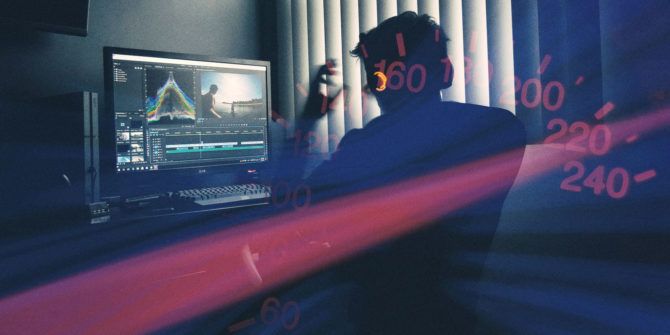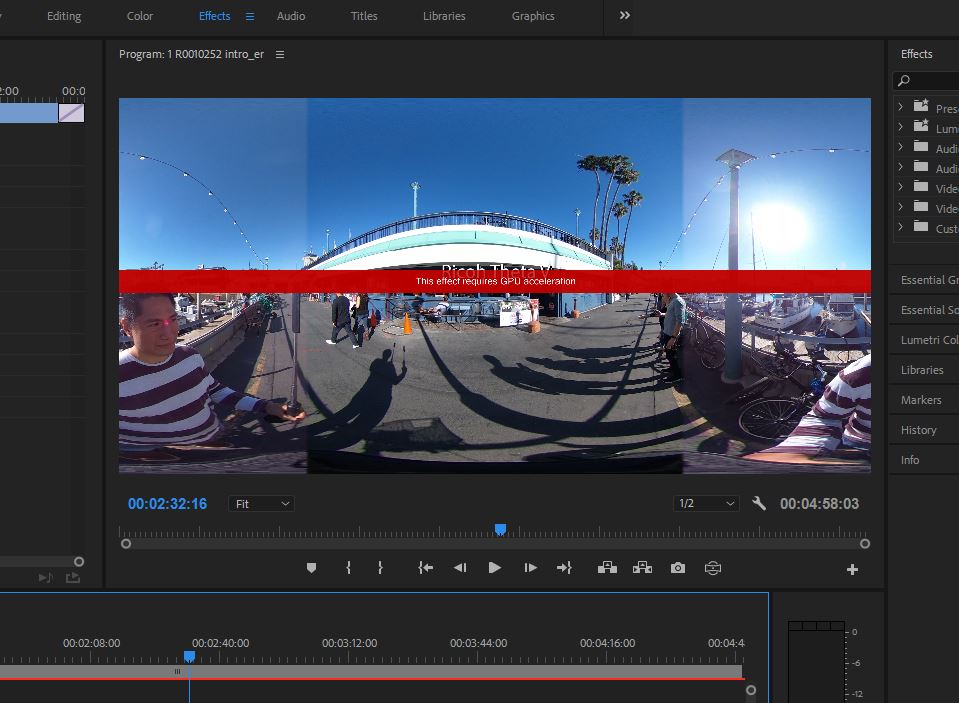- Adobe Premiere Playback Not Working
- Adobe Premiere Pro Free Download
- Adobe Premiere Pro Playback Lag
- Adobe Premiere Pro Free
Premiere Pro Upon launching Premiere Pro CC (lightning fast, by the way!), I noticed that only OpenCL processing was available in Project Settings Video Rendering and Playback Renderer. With the NVIDIA 650M GPU, I expected to see CUDA processing available, as well, as this video card supports both OpenCL and CUDA processing. UPDATE: For details of what was new regarding CUDA and OpenCL processing in Adobe Premiere Pro CS6, see this page. If you’re using Premiere Pro CS6 and later, note that nearly everything said below about CUDA also applies to OpenCL. UPDATE: For details of what was new regarding CUDA processing.
Mar 20,2019• Proven solutions
Many issues that are related to playback and performance are linked to the Media Cache and Media Cache Database.Media Cache contains the.CFA and.PEK files that are generated by Premiere Pro while importing clips for the first time in Project bin.Clearing cache files can help in solving such issues. Follow these steps to clear the cache files. If you’ve worked with Adobe Premiere Pro even a little bit, you’ve noticed that colored bars—red, yellow, and green—appear at the bottom of the time ruler at the top of the Timeline panel, above clips in a sequence. These colored bars are often referred to as render bars. But what do they mean, and what does this mean to your work?
It has become a recent trend that people want to watch their videos playing in reverse mode and for that reason they keep looking for some cool video editing software. Adobe Premiere Pro is a powerful video editing and production software with loads of exciting tools which help you edit the recorded clips the way you want. Many people find it difficult to operate and are often seen asking how to reverse/rewind clips in Adobe Premiere Pro? Here is a simple step by step guide that will help you get the answer of this frequently asked answer.
You may also like:How to Crop Videos in Adobe Premiere Pro >>
How to Create Freeze Frame in Adobe Premiere Pro 2017 >>
Adobe Premiere Pro is difficult to operate for some people. It has a complex user interface and also the trial period is very short. That is why many people do not opt for Adobe Premiere Pro. The best alternative of Adobe Premiere Pro is none other than FilmoraPro. It is a professional editor that is easy to use. If want to have a editor both professional and easy, FilmoraPro is the one. You can use it to reverse video clip, audio clip or both without effort. Besides reversing, you can also change video speed and resize your video. Download it to have a try (FREE).
In order to help you reverse/rewind clips using FilmoraPro, we present a simple step-by-step guide:
- Import the clip that you want to edit or reverse.
- Select and Drag the clip to the timeline that you want to reverse/rewind.
- Search 'reverse' at Effects library.
- If you want to reverse video clip, drag Time Reverse onto clip in the timeline.
- If you want to reverse audio clip, drag Audio Reverse onto clip as well.
- Now, it is done.
How to reverse/rewind clips in Adobe Premiere Pro Step by Step
- Launch Adobe Premiere Pro and click Import. Select the video clip that you want to edit.
- Right-click on the Clip's name in the Project Section of the Adobe Premiere Pro.
- Select Speed/Duration from the menu that opens from right-clicking on the Clip's name.
- Check the box right next to Reverse Speed from the dialogue box that opens.
- Click the OK button to reverse the clip.
- Drag the clip from the Project section onto the timeline.
- Click the Play button to watch the reversed clip.
Here is a video tutorial on how to reverse video in Adobe Premiere Pro
Conclusion
See this is as simple as that. But this can be very complicated for those people who like simple user interface and do not want to get into something that is difficult to operate. That is why most of the people start looking for alternatives. Here we recommend using FilmoraPro. It is the best video editor that is for intermediate users. If you want to have powerful and engaging video with easy to use interface, FilmoraPro won't let you regret!
Easy-to-use and powerful video editor for all creators.
Bring up your video to a professional level with straightforward tools.
- Choosing Video Editing Software
- Video Editing Tips
There is no sound during playback (preview) in Adobe Premiere Pro on Windows or Mac OS.
To fix this problem, you must first determine which clips have no sound during playback.
Perform the following steps (which create a test clip of color bars with a 1-kHz tone) to determine which clips are missing sound during playback.
In the Project panel, double-click Bars and Tone. The Bars and Tone clip opens in the Source Monitor.
If Bars and Tone clip doesn't open in the Source Monitor, then drag the clip to the Timeline.
Click the Play button in the Source Monitor (or play the clip from Timeline). If you do not hear the tone, then go to Sound is missing from all clips. If you do hear the tone, then go to Sound is missing from some clips.
If sound is missing from all clips in all projects, then do the following tasks in order:
1. Choose a system default audio device and check its volume.
Your computer could have more than one device that can play back audio (e.g., an internal speaker, external speakers, or headphones). Set your preferred device as the system default sound playback device, and then verify that its volume is not muted or set low.
Use the Control Panel to check your default audio device and its volume setting. If you need additional help using the Control Panel to check these settings, use the following Microsoft Help links:
Open an Adobe Premiere Pro project that contains audio clips, video clips with audio, or a Bars and Tone clip.
- Choose Premiere Pro > Preferences > Audio Hardware.
Choose an audio device:
Premiere Pro: Choose the audio device you want to use from the Adobe Desktop Audio menu (Premiere Pro) or Default Output menu (Premiere Pro CC 2015). Or click the Settings button to open the Settings dialog box, and choose your default audio device.
Premiere Pro CS6: Choose the audio device that you want to use from the Default Device menu.
Play a clip. If you still do not hear sound, then go back to Step 2 and try a different audio device.
2. (Windows) Adjust the audio hardware driver settings in Adobe Premiere Pro.

- Open an Adobe Premiere Pro project that contains audio clips, video clips with audio, or a Bars And Tone clip.
In the Default Device (Premiere Pro CS6) or Device Class (Premiere Pro) pop-up menu, choose an ASIO driver (if one is listed).
Otherwise, choose Premiere Pro WDM Sound (Premiere Pro CS6) or MME (Premiere Pro)
Enable your preferred device:
Premiere Pro: Click the Default Output menu and choose a device.
Premiere Pro CS6: Click the Output tab, then click the box to the left of the device name. Click OK to close the Audio Hardware Settings window.
For best results, enable the device that you chose as the system default playback device in Task 1.
Play a clip. If you still do not hear sound, then go back to Step 2 and try a different driver.
Note:
For more information on Premiere Pro audio drivers and audio hardware preferences, see Audio hardware preferences.
3. (Windows) Update the driver for your sound card, or install an ASIO driver.
If you don't hear sound after completing the tasks above, then the driver for your computer's sound card could be out-of-date. Many sound card manufacturers frequently update their software drivers. Contact the manufacturer of your sound card or the manufacturer of your computer for an updated driver, or download one from the manufacturer's website. When you have updated the driver, repeat the solutions above.
If no ASIO driver is installed and one is available for your sound card, then download and install the ASIO driver.
If sound is missing only from certain clips or only from clips in a certain project, then do the following tasks in order:
1. Check for disabled audio tracks (Premiere Pro CS6).
In the Timeline panel, look at the box at the far left or far upper left of each audio track's header. If no speaker icon appears in this box, then the track is disabled. To enable a disabled audio track, click in the box. A speaker icon appears.
In the illustrated example below, the speaker icon (circled) indicates that the Audio 1 track is enabled. On the right side, the empty box indicates that the Audio 1 track is disabled:
Use the Audio Mixer or Timeline panel to determine if an audio track is muted or has low volume, and to increase the volume if necessary.
Premiere Pro: Do one of the following:
- Open the Audio Mixer, choose Window > Audio Clip Mixer > [Sequence Name] or Window > Audio Track Mixer > [Sequence Name].
- In the Timeline panel, look at the box at the left.
If the M next to any of the tracks is highlighted, the audio is muted. Click M to turn sound on.
Premiere Pro CS6: To open the Audio Mixer, choose Window > Audio Mixer > [Sequence Name]. Check for muted or low-volume tracks.
Adobe Premiere Playback Not Working

3. Check for muted, low-volume, or disabled clips.
Verify that individual clip's volume is not muted or low. For instructions, see Adjust track volume with keyframes (CS6) or Monitor clip volume and pan using Audio Clip Mixer.
Also verify that individual clips are not disabled. For instructions, see Enable or disable a clip.
If you completed the steps above and you still don't hear sound, the problematic clips could have been encoded with an incompatible codec. Codecs are algorithms for compressing audio and video data. Many different codecs exist. Sometimes, Adobe Premiere Pro can't decode files that were encoded with a poorly designed codec or a codec that is not installed on your computer.
You can download third-party codecs from codec publishers' websites. If the codec used to create the clips isn't available as a QuickTime component, use other software to transcode them with a different audio-encoding format. (Try MPEG Streamclip or QuickTime Player with the QuickTime Pro upgrade.) Then, import the transcoded files into Adobe Premiere Pro.
To troubleshoot codec issues (on both Windows and Mac OS), see Troubleshoot file formats and codecs.
Sometimes, when you import the footage the footage may missing audio or video. To know more about this issue, see the KB article, No sound during playback.
Adobe Premiere Pro Free Download
More like this
Adobe Premiere Pro Playback Lag
Twitter™ and Facebook posts are not covered under the terms of Creative Commons.
Adobe Premiere Pro Free
Legal Notices | Online Privacy Policy